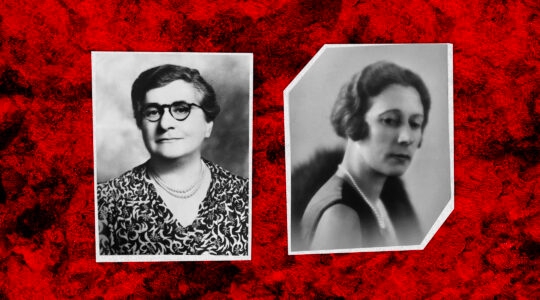ST. LOUIS PARK, Minn. (JTA) — Like most Jews involved in a synagogue or minyan, I believe that the ultimate quality and sustainability of the Jewish community will be determined by having a critical mass of people who care about God, Torah and Israel, however defined. Synagogues and their auxiliaries (e.g., youth, sisterhood, older adult groups), in addition to often being the local address for religiosity and spirituality, represent one of the most significant sources of social, educational and financial capital in the Jewish community. And synagogues are one of the last places where the potential for meaningful, multi-generational interaction is possible.
Synagogues often are under-resourced in good times. Now, even with belt tightening, they are at risk. On rabbinical Listserv mailing lists, stories about broken contracts, salary freezes or cuts, layoffs and reduction by attrition for the next several years are legion. Newspapers, network broadcasting, publishing, manufacturing and entertainment — all of these industries are experiencing tectonic shifts. Some will not survive, while those that do will look much different than today.
Without sounding alarmist, the synagogue community is likely experiencing the same kind of fundamental transition. Some will close, others will emerge with a new design.
One key strategy for survival and long-term vitality is ramping up collaboration at the local level. Synagogues and other Jewish institutions in close proximity need to inventory their services and programs, eliminate duplication and add resources through collaboration to fill in the gaps. In these tough times, they need to make it easy for people to participate in synagogue life. They can do so not just by cutting costs, but by pooling resources for the benefit of the Jewish community.
I am well aware of the two central objections to collaboration because I’ve heard them often when raising the issue:
* We’re too competitive to collaborate; we’ll risk losing our members to another synagogue.
* We’re too ideologically different to work together.
My response to the first objection is, “Get over it already!” If your local percentage of synagogue affiliation is 17 percent to 40 percent, which it is in just about every significant Jewish population center in the United States, which is your real competition: the synagogue nearest yours or the consumerist culture that surrounds you?
With regard to ideology, here’s a new acronym for our religious lexicon: TIRP-Troubled Ideology Relief Program. Denominational ideology matters to the professional and lay elite of each denomination and plays an important role in expanding spiritual approaches and engaging a multiplicity of individual religious temperaments. But pragmatic factors at the local level, including convenience, cost, educational quality, style of services and the perceived warmth of the synagogue, is what drives synagogue involvement.
At most local levels, ideology does not energize community, it enervates it. So relieve yourself of the trouble about ideology and collaboration because it’s manageable on the local level.
The extent to which national synagogue leadership is really aware of how deep in transition we are and what kind of collective thinking and planning is happening to ensure that synagogues remain viable is unclear. Our current environment creates significant management challenges. Each denomination is responsibly struggling with how to provide valuable services and programs to its member congregations.
While very painful, it’s relatively easy to work on the management of resources during these difficult times because synagogues have limited options from which to choose. But what worries me is that we are not addressing the leadership challenges that are testing synagogues and that we do not have the structures or will to address them.
Management is about working effectively within existing structures, while leadership is about envisioning new ones. And here is why there is a dire need for visionary spiritual leadership:
* The small number of Jews who already describe themselves as religiously observant continue to drop and is now at 1.2 percent, or 2.7 million people, according to the recently released American Religious Identification Survey. (The drop is consistent with another survey reporting that traditional organized religions are playing less of a role in the lives of Americans.)
* Because of the high cost of being Jewish, formative Jewish experiences such as synagogue involvement are increasingly open only to the financially privileged.
* Funding for Jewish causes across the board may shrink by as much as a third in proportion to financial losses in the Jewish community. How do financially demoralized synagogues remain spiritually viable?
With most leaders looking after their own organizational self-interest, who is thinking and working on these broader issues?
Volunteers and professionals at the local level need to take the destiny of their Jewish communities into their own hands. They are best poised to think imaginatively about ways to collaborate to strengthen their own institution while reaching out broadly beyond their own walls.
Solutions cannot be imposed from the top down. However, denominational leaders can support this process by sending a clear message about the imperative of collaboration at the regional and local levels.
Rabbi Hayim Herring is executive director of STAR (Synagogues: Transformation and Renewal). He is writing a book called” Tools for Shuls: A Guide to Make Over Your Synagogue” (www.toolsforshuls.com).
Normal
0
MicrosoftInternetExplorer4
/* Style Definitions */
table.MsoNormalTable
{mso-style-name:”Table Normal”;
mso-tstyle-rowband-size:0;
mso-tstyle-colband-size:0;
mso-style-noshow:yes;
mso-style-parent:””;
mso-padding-alt:0in 5.4pt 0in 5.4pt;
mso-para-margin:0in;
mso-para-margin-bottom:.0001pt;
mso-pagination:widow-orphan;
font-size:10.0pt;
font-family:”Times New Roman”;}
JTA has documented Jewish history in real-time for over a century. Keep our journalism strong by joining us in supporting independent, award-winning reporting.





